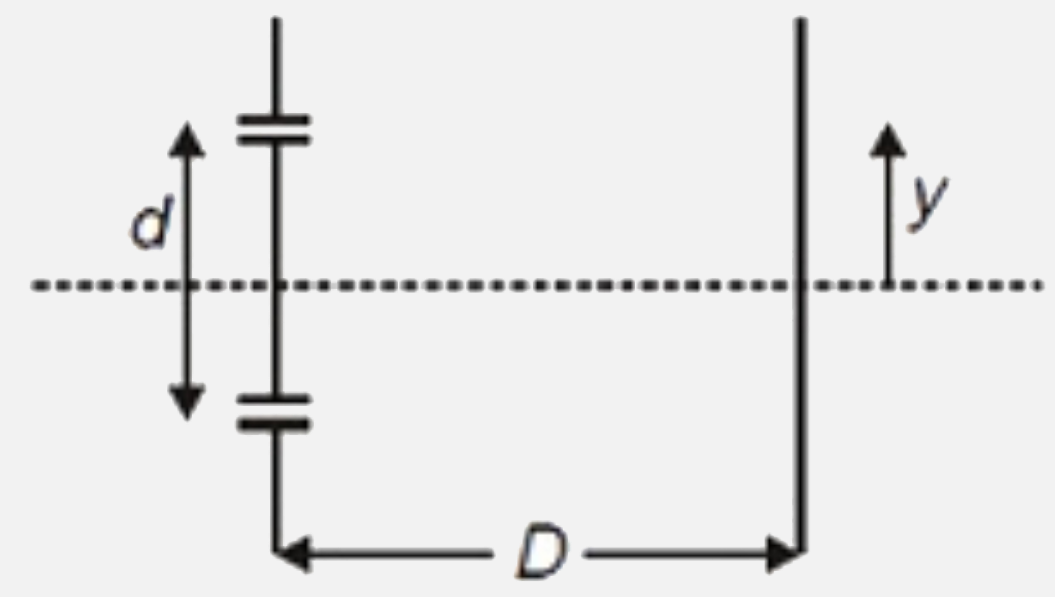A beam of light consisting of wavelengths 6000 Å and 4500 Å is used in a YDSE with D = 1 m and d = 1 mm. Find the least distance from the central maxima, where bright fringes due to the two wavelengths coincide.
0.9 mm
1.2 mm
1.8 mm
1.4 mm
The correct Answer is:C
β1=λ1Dd=6000×10−10×110−3=0.6mm
β2=λ2Dd=0.45mm
Let n1 th maxima of λ1andn2th maxima of λ2 coincide at a position y.
then , y=n1β1=n2β2=LCM of β1β2
⇒y=LCM of 0.6 mm and 0.45 mm
y=1.8mm
At this point 3rd maxima for 6000 Å & 4th maxima for 4500 Å coincide
Topper's Solved these Questions
Similar Questions
In YDSE a parallel beam of incident light consists of two wavelengths λ1=4000Åandλ2=5600Å. The minimum distance y on the screen, measured from the central axis, where the bright fringe due to two wavelengths coincide is nλ1Dd. Find n.
 View Solution
View SolutionA light consisting of two wavelengths 650 nm and 520 nm is used to obtain interference fringes in a Young's double slit experiment. Find the least distance (in mm) from a central maximum where the bright fringes due to both the wavelengths coincide? It is given that the distance between the slits is 3 mm and the distance between the plane of the slits and screen is 150 cm.
View Solution
Knowledge Check
- Question 1 - Select One
A beam of light consisting of two wavelengths 650nm and 520nm is used to obtain interference fringes in a Young's double slit experiment.
(a) Find the distance of the third bright fringe on the screen from the central maximum for the wavelength 650nm.
(b) What is the least distance from the central maximum where the bright fringes due to both the wavelengths coincide? The distance between the slits is 2mm and the distance between the plane of the slits and screen is 120cm.A0.16cmB0.32cmC0.48cmD1.92cm - Question 2 - Select One
A beam of light consisting of two wavelength 6500Å&5200Åis used to obtain interferance fringes in a young's double slit experiment .The distance between the slits is 2.0mm and the distance between the plane of the slits and thescreen is 120cm,.what is the least distance from the central maximum where the bright fringes due to both the wave length coincides?
A0.156cmB0.152cmC0.17cmD0.16cm
A beam of light consisting of two wavelengths 650nm and 520nm is used to obtain interference fringes in a Young's double slit experiment.
(a) Find the distance of the third bright fringe on the screen from the central maximum for the wavelength 650nm.
(b) What is the least distance from the central maximum where the bright fringes due to both the wavelengths coincide? The distance between the slits is 2mm and the distance between the plane of the slits and screen is 120cm.View Solution(a) In Young's double slit experiment, a monochromatic source of light S is kept equidistant from the slits S1andS2. Explain the information of dark and bright fringes on the screen.
(b) A beam of light consisting of two wavelength, 650 nm and 520 nm, is used to obtain interference fringes in a Young's double - slit experiment.
(i) Find the distance of the third bright fringe on the screen from the central maximum for wavelengths 650 nm.
(ii) What is the least distance from the central maximum where the bright fringes due to both the wavelengths coincide ?
Given: The seperation between the slits is 4 mm and the distance between the screen and plane of the slits is 1.2 m.View SolutionA beam of light consisting of two wavelengths 650nmand520nm, is used to obtain interference fringes in a Young's double slit experiment. (a) Find the distance of the third bright fringe on the screen from the central maximum for wavelength 650nm. (b) What is the least distance from the central maximum, where the bright fringes due to both the wavelength coincide ?
View SolutionA beam of light consisting of two wavelengths 6500Å and 5200Å is used to obtain interference fringes in a young's double slit experiment the distanece between the slits is 2mm and the distance between the plane of the slits and screen is 120 cm.
(a). Find the distance of the third bright fringe on the screen from the central maxima for the wavelength 6500Å
(b). What is the least distance from the central maxima where the bright fringes due to both the wave lengths coincide?View SolutionA beam of light consisting of two wavelenths, 6500 Å and 5200 Å is used to obtain interference fringes in a Young's double slit experiment (1Å=10−10m). The distance between the slits is 2.0 mm and the distance between the plane of the slits and the screen in 120 cm. (a) Find the distance of the third bright frings on the screen from the central maximum for the wavelength 6500 Å (b) What is the least distance from the central maximum where the bright frings due to both the wavlelengths coincide ?
View SolutionA beam of light consisting of two wavelengths, 6500 Å and 5200Å , is used, to obtain, interference fringes in a Young’s double slit experiment
Q(a) Find the distance of the third bright fringe on the screen from the central maximum for wavelength 6500 Å
.) What is the least distance form the central maximum where the bright fringes due to both wavelengths coincide?
The distance between the slits is 2 mm and the distance between the plane of slits and p the screen is 120 cm.View Solution

